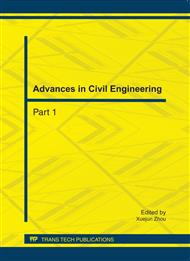p.3039
p.3043
p.3047
p.3051
p.3057
p.3061
p.3068
p.3073
p.3077
Analysis of Heat Loss of Ground Pipeline of Thermal Production Oilfield
Abstract:
Steam stimulation is one of the main methods used in heavy oil reservoir development. How to inject high temperature and high dryness steam is a key factor to enhance heavy oil recovery. It is significant to evaluate heat transfer of steam pipeline and optimize thermal insulation layer for heavy oil exploitation. Based on fluid mechanics, heat transfer theory, considered phase change, mathematical model to calculate heat transfer and heat loss of steam pipeline was derived. Using COMSOL Multiphysics, a finite element based program for simulating unlimited multiphysics and single physics applications, the author simulated heat transferring in ground steam pipeline and analyzed the effect of thermal insulation layer. From the simulation results, it was known that, (1) Along with the pipeline distance increases, the steam dryness decreases, the decrease rate decreases with the distance increases. (2) At the same transmission distance, the bigger the thermal insulation layer thickness is, the smaller the heat loss of the steam is. The heat loss of steam transmission mainly center on the first half pipeline. (3) With the thickness of thermal insulation layer increases, the heatloss declines. After the thickness of thermal insulation layer increases 90 mm, increasing the thickness has no obvious effect on reducing the heat loss. So, it is suggested that the thermal insulation layer thickness should be 75-80mm.
Info:
Periodical:
Pages:
3057-3060
Citation:
Online since:
September 2011
Authors:
Price:
Сopyright:
© 2011 Trans Tech Publications Ltd. All Rights Reserved
Share:
Citation:


